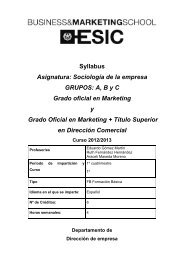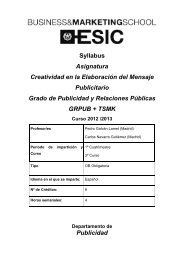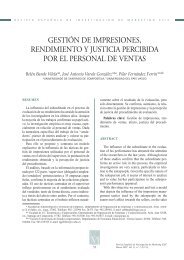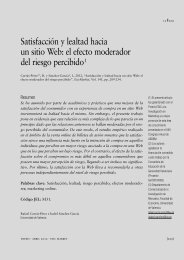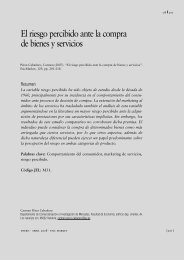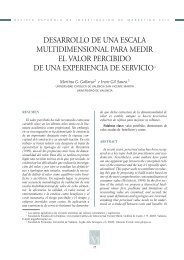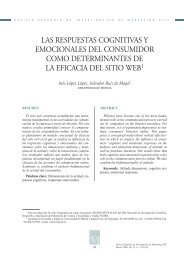Corporate social responsability and loyalty in services sector - Esic
Corporate social responsability and loyalty in services sector - Esic
Corporate social responsability and loyalty in services sector - Esic
You also want an ePaper? Increase the reach of your titles
YUMPU automatically turns print PDFs into web optimized ePapers that Google loves.
210 11<br />
Figure 2. Model of <strong>loyalty</strong><br />
[210]<br />
Ethical-Legal Social<br />
0.91<br />
0.81<br />
corporate <strong>social</strong> <strong>responsability</strong> <strong>and</strong> <strong>loyalty</strong> <strong>in</strong> <strong>services</strong> <strong>sector</strong><br />
Technique Q.<br />
0.81<br />
0.64<br />
Functional Q. Perceived Q.<br />
0.77<br />
Commercial<br />
Responsibility<br />
<strong>Corporate</strong> Social<br />
Responsibility Loyalty<br />
0.65<br />
Global Image<br />
0.37<br />
0.74<br />
Switch<strong>in</strong>g<br />
costs<br />
Social <strong>and</strong> commercial responsibilities are regarded as direct determ<strong>in</strong>ants<br />
of the overall evaluation of the company, <strong>and</strong> therefore, as hav<strong>in</strong>g a<br />
direct <strong>in</strong>fluence on <strong>loyalty</strong>. With respect to this, it is proven that commercial<br />
responsibility is the ma<strong>in</strong> determ<strong>in</strong>ant of image (hypothesis 4 is not<br />
refuted), while <strong>social</strong>ly responsible behaviour has no significant effect.<br />
Although <strong>in</strong> experimental studies the relationship did appear to be significant,<br />
it seems that when tak<strong>in</strong>g direct knowledge <strong>and</strong> evaluation measures<br />
the output varies. This result leads us to reject hypothesis 5. Thus, users let<br />
themselves be guided by their direct experiences with the service when<br />
called upon to evaluate a company, while <strong>social</strong> responsibility plays a secondary<br />
role. Perhaps this is due, as Mohr <strong>and</strong> Webb (2005) prove, to<br />
image be<strong>in</strong>g more affected by receiv<strong>in</strong>g <strong>in</strong>formation about negative practices<br />
than about positive ones, i.e., consumers react very negatively to<br />
<strong>in</strong>formation over irresponsible practice, while they are less sensitive to positive<br />
messages (Sen <strong>and</strong> Battacharya, 2001).<br />
0.40<br />
0.16<br />
Hypothesis supported<br />
Hypothesis not supported<br />
january · april 2011 · esic market




